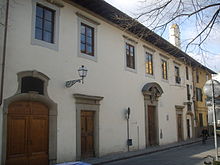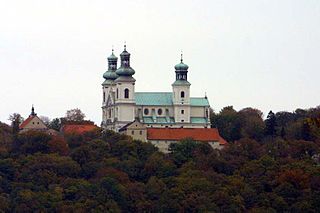
The Camaldolese monks and nuns are two different, but related, monastic communities that trace their lineage to the monastic movement begun by Saint Romuald.

Campagna is a small town and comune of the province of Salerno, in the Campania region of Southern Italy. In 2010, its population was 16,183.

The Vallumbrosan Order is a Roman Catholic religious order, technically a Benedictine congregation, which derives its name from the motherhouse, Vallombrosa, situated c. 30 km from Florence on the northwest slope of Monte Secchieta in the Pratomagno chain. They use the abbreviation O.S.B. Vall., the Vall. to distinguish themselves from the Benedictines, who use the abbreviation O.S.B.

The Abbazia di San Salvatore or Abbadia San Salvatore is an abbey on the Monte Amiata, in the town of Abbadia San Salvatore, Tuscany, Italy, to which it gives its name.
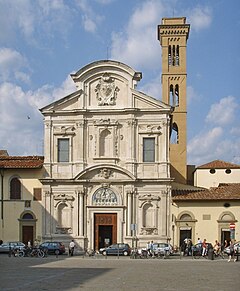
The chiesa di San Salvatore di Ognissanti or more simply chiesa di Ognissanti, is a Franciscan church located on the piazza of the same name in central Florence, region of Tuscany, Italy. Founded by the lay order of the Umiliati, the church was dedicated to all the saints and martyrs, known and unknown.

San Marco is the name of a religious complex in Florence, Italy. It comprises a church and a convent. The convent, which is now the Museo Nazionale di San Marco, has three claims to fame. During the 15th century it was home to two famous Dominicans, the painter Fra Angelico and the preacher Girolamo Savonarola. Also housed at the convent is a famous collection of manuscripts in a library built by Michelozzo.

Camaldoli is a frazione of the comune of Poppi, in Tuscany, Italy. It is mostly known as the ancestral seat of the Camaldolese monastic order, originated in the eponymous hermitage, which can still be visited.

San Frediano in Cestello is a Baroque-style, Roman Catholic church in the Oltrarno section of Florence, region of Tuscany, Italy. The name cestello derives from the Cistercians who occupied the church in 1628. Previously the site had a 1450s church attached to the cloistered Carmelite convent of Santa Maria degli Angeli.

Longobards in Italy: Places of Power is seven groups of historic buildings that reflect the achievements of the Germanic tribe of the Lombards, who settled in Italy during the sixth century and established a Lombard Kingdom which ended in 774 A.D.

San Michele degli Scalzi is a church located in Piazza San Michele degli Scalzi, east of Pisa, Italy. It had also been known as the church of San Michele degli Scalzi in Orticaia, referring to the nature of the site at the time of its founding. The term Scalzi refers to the barefoot monks linked to the church. Dating back to the 11th century, it has been restored several times in the original Romanesque style.
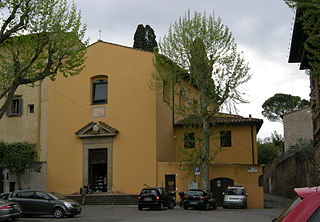
San Francesco di Paola is a small Renaissance-style Roman Catholic church in the Oltrarno quarter of Florence, central Italy.

Santa Croce in Fossabanda is a Renaissance-style Roman Catholic church and monastery in Pisa, region of Tuscany, Italy.

The Teatro Goldoni of Florence was first opened in 1817 at the site of the former Annalena monastery in Oltrarno, region of Tuscany, Italy. The theater, dedicated to the playwright Carlo Goldoni, has a main facade on the narrow Via Santa Maria #15, it is near the corner with Via de Caldaie.
The Evangelical Methodist Church of Florence is an Italian Methodist church located on via de' Benci #9 of Florence, region of Tuscany, Italy. The congregation occupies the former Roman Catholic church of San Jacopo tra i Fossi, founded in the 12th century. It was originally staffed by Vallombrosian monks of San Salvi, but by 1543 it was transferred to the Augustinian order that had remained faithful to Cosimo I. The present church was rebuilt in the 17th century. The adjacent convent and church were suppressed in 1808. The church was allocated in 1874 to the Scottish missionary John R. MacDougall. As of 2013, the Methodist Church is currently cared for by the pastor of the Waldensian Church of Florence, and the Tuscany Methodist Circuit.
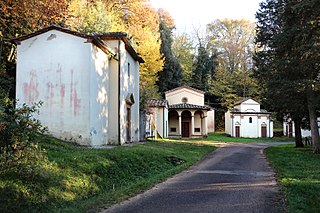
San Vivaldo Monastery is a Roman Catholic convent, church, and sanctuary complex located outside of the town of Montaione, region of Tuscany, Italy. The eighteen distinct chapels on this hill, putatively corresponding to sites of the Holy Land, and containing vivid polychrome statuary groupings recalling events of the New Testament, specially The Passion, are one of the few examples of the Sacri Monti complexes in Tuscany. Sacri Monti are more characteristic expressions of veneration in the Piedmont and Lombardy. The convent still houses the franciscan order.
San Paolo Apostolo, more commonly known as San Paolino, is a Romanesque-style, Roman Catholic church and convent located in Via di S. Paolino #8, in central Florence, region of Tuscany, Italy. The church is near the Church of the Ognissanti.

The Convent of Bosco ai Frati is located in the comune (municipality) of Scarperia e San Piero, in the midst of Turkey oak woods. The area is in the province of Florence in the Italian region Tuscany, and is situated about 25 kilometres northeast of Florence.
The Badia of Santi Salvatore e Cirino is a former Cistercian monastery located east of the village of Monteriggioni, in the province of Siena in the Italian region of Tuscany. The abbey is also known as the Badia a Isola or Abbazia dei Santi Salvatore e Cirino. The monastic buildings include an inn, restaurant and halls for cultural events.



